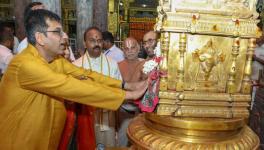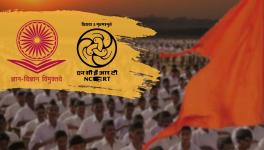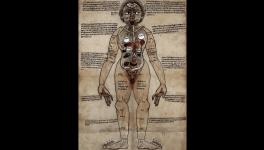HISTORY MYTH BUSTING SERIES-I: No Evidence for Indigenous Aryans

The Indus Civilisation was not part of the Vedic civilisation. The introduction of Vedic culture in India is explained by the Aryan Migration Theory. The Aryans originated from the Kazakh Steppe in Northern Kazakhstan and eventually migrated southward into the Indian subcontinent. | (Representational image. | Image courtesy: Unsplash)
In past few years, many debates and contentions about history have moved from the academic sphere and entered a wider public forum. A battleground has emerged where particular cultures, narratives and ideologies are pitted against others in order to prove one as dominant and superior to others. The Hindu Right is a major proponent of many such false narratives which aim to establish a particular version of Hindu culture and ideology as the sole and rightful heir to India’s varied history and culture. Such false narratives abandon what the academic world has established through evidence, and they rely on getting traction through popular media, including social media. Newsclick is publishing a series of brief explainers based on evidence-based scholarly research that counter some of these prominent myths propagated by Hindutva forces.
The Aryan debate has gained renewed importance in the past two decades. This is a result of new evidence, interpretations and the pushing of competing narratives. From being a scholarly debate, it has now entered the public forum and acquired a new character. It is a deeply political and emotional topic due to its impact on our sense of identity as Indians.
The issue at stake is whether or not the ‘Aryans’ were an indigenous people responsible for our first civilisation and whose beliefs have ever since formed the core of Indian culture. The Hindu Right asserts that Aryans are the original inhabitants of India and modern Hindus are their direct descendants, thus giving legitimacy to the idea of India being a traditionally Hindu nation which rightfully belongs to the Hindus.
The crux of the debate is this, there can only be two possibilities in the relationship of the Indus Civilisation and the Aryans. The Aryans were either there before the Indus civilisation and were its founders, or they came in after it declined. Anyone arguing for the indigeneity of Aryans must establish that the Indus Civilisation was Vedic. Certain sites of the Indus Civilisation are located along the Ghaggar-Hakra valley and it is argued that it is identical with the Saraswati which is an important river for the composers of the Rigveda (ancient Hindu scripture). In fact, these sites are claimed to be the centre from which the rest of the Indus Civilisation emerged and spread.
Further, it is claimed that rather than the Aryans entering India, they migrated out of the sub-continent and spread through the rest of the world. It is important to note here that the term ‘Aryan’ is not a racial term. It refers to a group of people who spoke Indo-European languages and called themselves ‘Aryas’, and the meaning of this term changes throughout the Vedas.
The Indus Civilisation, also referred to as the Harappan Civilisation, was one which lasted from 2600–1900 BCE. It was spread across an expansive area, covering most of Punjab (both Indian and Pakistani territories), Haryana, parts of western Uttar Pradesh and northern Rajasthan, Sindh, most of Gujarat as well as parts of northeastern and southern Baluchistan.
Historians are faced with a unique problem in studying this civilisation, that is, they haven’t deciphered its language script yet. This forces us to rely primarily on archaeological, geographical and genetic evidence. Certain key features of the civilisation have been established and are used to identify sites belonging to it. These include the Indus script, baked and sun-dried bricks made in the ratio of 1:2:4, standard weights based on a unit of 13.63 grams, presence of straight roads in urban and semi-urban settlements, planned out drainage systems, citadels built adjacent to towns, masonry wells and tanks, distinctive wheel made pottery and specific burial rites where the dead were laid supine and aligned north-south.
The decline of this civilisation has been attributed to a number of reasons, which are often disputed. These include a changing climate (wet and dry periods), a manmade ecological disaster, loss of external trade with the rest of Asia, and a collapse of the State system.
The Aryans were a group of Indo-European language speakers. They are credited with writing the Vedic texts. Historians have been able to gain a general idea about their culture, norms and society by examining various Vedic texts such as the Rigveda. However, it must be noted that there is no one ‘Vedic Society’, the Vedic texts developed over centuries in different region. Historians can trace changes within those societies rather than perfectly narrow down what a particular ‘Vedic society’ was like at a particular time. An example of this is an increased mention of the use of grains, such as rice or barley, in the later Vedic texts, which shows the growing popularity of agriculture by the time these texts were composed.
When looking at the Indus Civilisation and the Aryans, historians find two different societies in terms of political organisation, societal structuring, main mode of subsistence, and religion. Through archaeological evidence, they have been able to establish the Indus Civilisation as an organised urban society, which at one point had a central political power, engaged in external trade and practiced settled agriculture.
Through literary evidence, the early Vedic society can be understood as a non-urban pastoralist society, with a chief-based political system and a ritualised religion. Within the Vedic texts, horses are mentioned repeatedly but no evidence has been found of horses at Indus Civilisation sites, apart from the remains of a wild ass (onager) at Surkotada.
Historians are also unable to find similarities in their religions. The main gods and goddesses of the Rigveda such as Indra, Agni or Varuni, find no representation in the Indus Civilisation nor are they able to decipher Indus imagery by referring to Vedic texts. There is a clear disparity in terms of how these societies were structured and operated, making it impossible to claim them as one and the same.
There is no archaeological evidence that shows the Ghaggar-Hakra valley as the primary centre of the Indus Civilisation. The sites found along this valley are also small, with only one large settlement, called Ganweriwala, present. One can’t be sure that Ghaggar-Hakra is the same as the Saraswati which is described in the Rigveda, instead Saraswati might actually refer to the Haraxvati plain in Afghanistan.
Aryan Migration Theory
It is now clear that the Indus Civilisation was not part of the Vedic civilisation. The introduction of Vedic culture in India is explained by the Aryan Migration Theory. According to this, the Aryans originated from the Kazakh Steppe in Northern Kazakhstan and eventually migrated southward into the Indian subcontinent. Through genetic mapping, researchers are able to trace the Aryan migration from the Kazakh Steppe to South Asia. The southward migration from the steppes started around 2100 BCE and reached South Asia sometime between 2000 –1500 BCE.
There is also evidence from 12 samples of ancient DNA from members of the Indus Civilisation, one from Rakhigarhi and 11 from migrants whose skeletons were found in Shehr-i-Sokhta and Gonur. The conclusions reached from these samples are that they were a mixture of Iranians and the First Indians (out-of-Africa migrants who reached the subcontinent around 65,000 years ago). No Steppe ancestry, which is linked with the Aryans, was found in these samples, clearly showing that they were not present when the Indus Civilisation was at its peak.
To put this finding into context, today the Steppe DNA is found commonly across India, meaning that at some point it was introduced due to a migration. This genetic evidence correlates with linguistic evidence, which traces these migrations by looking at how different languages have migrated, interacted and evolved. In this case, the spread of Proto-Indo-European, and its descendants such as Sanskrit, Greek and Latin are used to trace these migrations.
According to Tony Joseph’s Early Indians, the members of the Indus Civilisation did not simply disappear after its decline. Instead, they spread out across the Indian subcontinent, seeking new fertile lands. Around this time, the Aryans began migrating to the subcontinent, bringing their own unique culture along with them. What would have happened here is an interaction between the two cultures and populations.
By claiming a singular ancestry, that of the Aryans, we are depriving ourselves of a more holistic understanding of our origins. There is a diversity in terms of the cultures, societies and even DNA present across India which cannot be ignored. However, the narratives, as woven by the Hindu Right, seek to establish their culture as the dominant and superior one. This series seeks to combat such narratives by developing a holistic understanding of the history of India.
The writer is an intern with NewsClick. The views are personal.
Get the latest reports & analysis with people's perspective on Protests, movements & deep analytical videos, discussions of the current affairs in your Telegram app. Subscribe to NewsClick's Telegram channel & get Real-Time updates on stories, as they get published on our website.
























